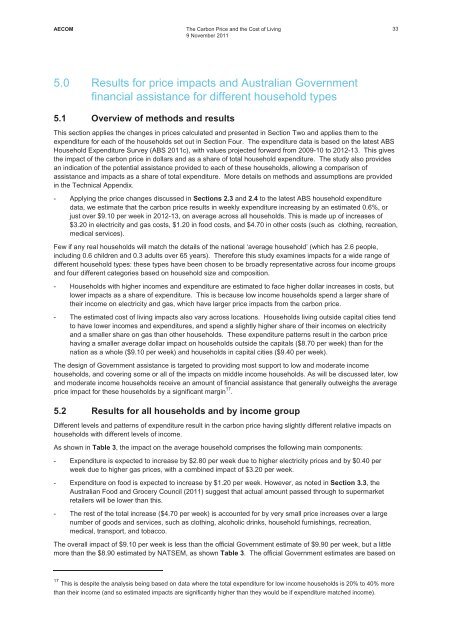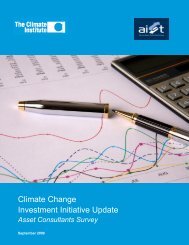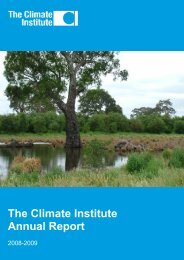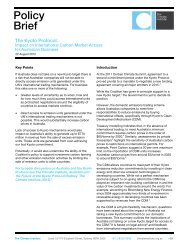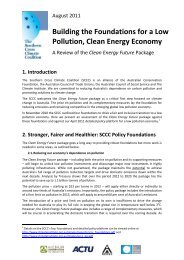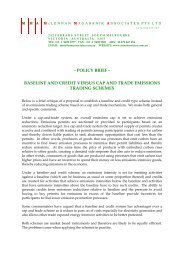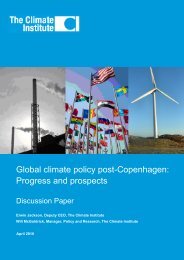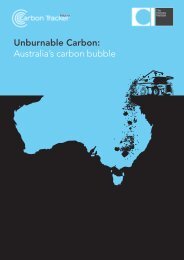The Carbon Price and the Cost of Living - The Climate Institute
The Carbon Price and the Cost of Living - The Climate Institute
The Carbon Price and the Cost of Living - The Climate Institute
Create successful ePaper yourself
Turn your PDF publications into a flip-book with our unique Google optimized e-Paper software.
AECOM<br />
<strong>The</strong> <strong>Carbon</strong> <strong>Price</strong> <strong>and</strong> <strong>the</strong> <strong>Cost</strong> <strong>of</strong> <strong>Living</strong><br />
9 November 2011<br />
33<br />
5.0 Results for price impacts <strong>and</strong> Australian Government<br />
financial assistance for different household types<br />
5.1 Overview <strong>of</strong> methods <strong>and</strong> results<br />
This section applies <strong>the</strong> changes in prices calculated <strong>and</strong> presented in Section Two <strong>and</strong> applies <strong>the</strong>m to <strong>the</strong><br />
expenditure for each <strong>of</strong> <strong>the</strong> households set out in Section Four. <strong>The</strong> expenditure data is based on <strong>the</strong> latest ABS<br />
Household Expenditure Survey (ABS 2011c), with values projected forward from 2009-10 to 2012-13. This gives<br />
<strong>the</strong> impact <strong>of</strong> <strong>the</strong> carbon price in dollars <strong>and</strong> as a share <strong>of</strong> total household expenditure. <strong>The</strong> study also provides<br />
an indication <strong>of</strong> <strong>the</strong> potential assistance provided to each <strong>of</strong> <strong>the</strong>se households, allowing a comparison <strong>of</strong><br />
assistance <strong>and</strong> impacts as a share <strong>of</strong> total expenditure. More details on methods <strong>and</strong> assumptions are provided<br />
in <strong>the</strong> Technical Appendix.<br />
- Applying <strong>the</strong> price changes discussed in Sections 2.3 <strong>and</strong> 2.4 to <strong>the</strong> latest ABS household expenditure<br />
data, we estimate that <strong>the</strong> carbon price results in weekly expenditure increasing by an estimated 0.6%, or<br />
just over $9.10 per week in 2012-13, on average across all households. This is made up <strong>of</strong> increases <strong>of</strong><br />
$3.20 in electricity <strong>and</strong> gas costs, $1.20 in food costs, <strong>and</strong> $4.70 in o<strong>the</strong>r costs (such as clothing, recreation,<br />
medical services).<br />
Few if any real households will match <strong>the</strong> details <strong>of</strong> <strong>the</strong> national ‘average household’ (which has 2.6 people,<br />
including 0.6 children <strong>and</strong> 0.3 adults over 65 years). <strong>The</strong>refore this study examines impacts for a wide range <strong>of</strong><br />
different household types: <strong>the</strong>se types have been chosen to be broadly representative across four income groups<br />
<strong>and</strong> four different categories based on household size <strong>and</strong> composition.<br />
- Households with higher incomes <strong>and</strong> expenditure are estimated to face higher dollar increases in costs, but<br />
lower impacts as a share <strong>of</strong> expenditure. This is because low income households spend a larger share <strong>of</strong><br />
<strong>the</strong>ir income on electricity <strong>and</strong> gas, which have larger price impacts from <strong>the</strong> carbon price.<br />
- <strong>The</strong> estimated cost <strong>of</strong> living impacts also vary across locations. Households living outside capital cities tend<br />
to have lower incomes <strong>and</strong> expenditures, <strong>and</strong> spend a slightly higher share <strong>of</strong> <strong>the</strong>ir incomes on electricity<br />
<strong>and</strong> a smaller share on gas than o<strong>the</strong>r households. <strong>The</strong>se expenditure patterns result in <strong>the</strong> carbon price<br />
having a smaller average dollar impact on households outside <strong>the</strong> capitals ($8.70 per week) than for <strong>the</strong><br />
nation as a whole ($9.10 per week) <strong>and</strong> households in capital cities ($9.40 per week).<br />
<strong>The</strong> design <strong>of</strong> Government assistance is targeted to providing most support to low <strong>and</strong> moderate income<br />
households, <strong>and</strong> covering some or all <strong>of</strong> <strong>the</strong> impacts on middle income households. As will be discussed later, low<br />
<strong>and</strong> moderate income households receive an amount <strong>of</strong> financial assistance that generally outweighs <strong>the</strong> average<br />
price impact for <strong>the</strong>se households by a significant margin 17 .<br />
5.2 Results for all households <strong>and</strong> by income group<br />
Different levels <strong>and</strong> patterns <strong>of</strong> expenditure result in <strong>the</strong> carbon price having slightly different relative impacts on<br />
households with different levels <strong>of</strong> income.<br />
As shown in Table 3, <strong>the</strong> impact on <strong>the</strong> average household comprises <strong>the</strong> following main components:<br />
- Expenditure is expected to increase by $2.80 per week due to higher electricity prices <strong>and</strong> by $0.40 per<br />
week due to higher gas prices, with a combined impact <strong>of</strong> $3.20 per week.<br />
- Expenditure on food is expected to increase by $1.20 per week. However, as noted in Section 3.3, <strong>the</strong><br />
Australian Food <strong>and</strong> Grocery Council (2011) suggest that actual amount passed through to supermarket<br />
retailers will be lower than this.<br />
- <strong>The</strong> rest <strong>of</strong> <strong>the</strong> total increase ($4.70 per week) is accounted for by very small price increases over a large<br />
number <strong>of</strong> goods <strong>and</strong> services, such as clothing, alcoholic drinks, household furnishings, recreation,<br />
medical, transport, <strong>and</strong> tobacco.<br />
<strong>The</strong> overall impact <strong>of</strong> $9.10 per week is less than <strong>the</strong> <strong>of</strong>ficial Government estimate <strong>of</strong> $9.90 per week, but a little<br />
more than <strong>the</strong> $8.90 estimated by NATSEM, as shown Table 3. <strong>The</strong> <strong>of</strong>ficial Government estimates are based on<br />
17 This is despite <strong>the</strong> analysis being based on data where <strong>the</strong> total expenditure for low income households is 20% to 40% more<br />
than <strong>the</strong>ir income (<strong>and</strong> so estimated impacts are significantly higher than <strong>the</strong>y would be if expenditure matched income).


